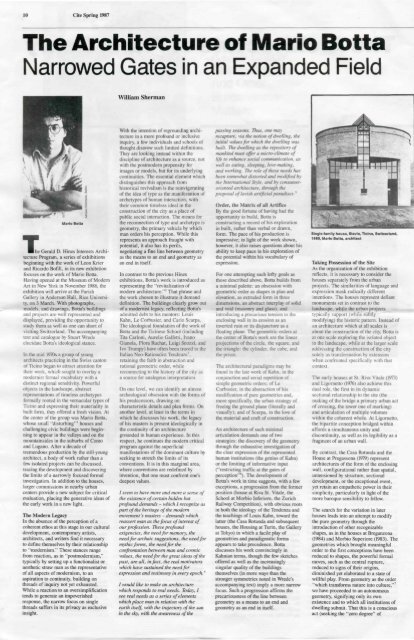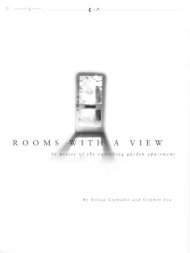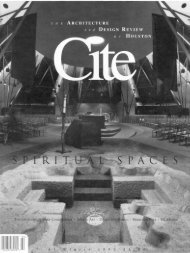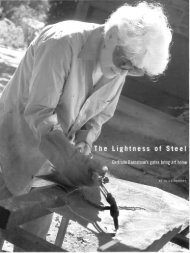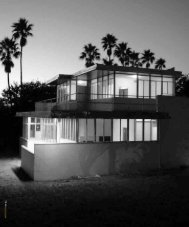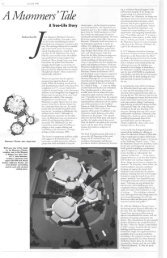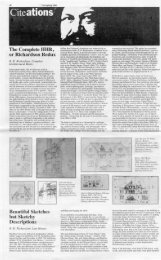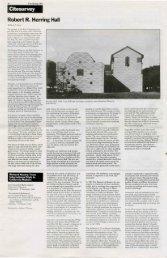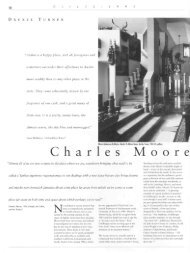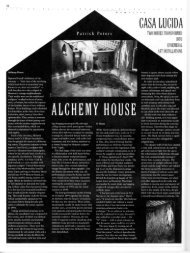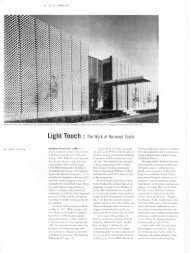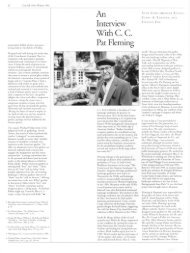The Architecture of Mario Botta Narrowed Gates in an Expanded Field
The Architecture of Mario Botta Narrowed Gates in an Expanded Field
The Architecture of Mario Botta Narrowed Gates in an Expanded Field
Create successful ePaper yourself
Turn your PDF publications into a flip-book with our unique Google optimized e-Paper software.
10 Cite Spr<strong>in</strong>g 1987<br />
<strong>The</strong> <strong>Architecture</strong> <strong>of</strong> <strong>Mario</strong> <strong>Botta</strong><br />
<strong>Narrowed</strong> <strong>Gates</strong> <strong>in</strong> <strong>an</strong> Exp<strong>an</strong>ded <strong>Field</strong><br />
William Sherm<strong>an</strong><br />
%<br />
<strong>Mario</strong> <strong>Botta</strong><br />
I I he Gerald D. H<strong>in</strong>es Interests <strong>Architecture</strong><br />
Program, a series <strong>of</strong> exhibitions<br />
beg<strong>in</strong>n<strong>in</strong>g with the work <strong>of</strong> Leon Krier<br />
<strong>an</strong>d Ricardo B<strong>of</strong>ill. <strong>in</strong> its new exhibition<br />
focuses on the work <strong>of</strong> <strong>Mario</strong> <strong>Botta</strong>.<br />
Hav<strong>in</strong>g opened al the Museum <strong>of</strong> Modern<br />
Art <strong>in</strong> New York <strong>in</strong> November 1986, the<br />
exhibition will arrive at the Farish<br />
Gallery <strong>in</strong> Anderson Hall, Rice University,<br />
on 3 March. With photographs,<br />
models, <strong>an</strong>d draw<strong>in</strong>gs, <strong>Botta</strong>'s build<strong>in</strong>gs<br />
<strong>an</strong>d projects are well represented <strong>an</strong>d<br />
displayed, provid<strong>in</strong>g the opportunity to<br />
study them as well as one c<strong>an</strong> short <strong>of</strong><br />
visit<strong>in</strong>g Switzerl<strong>an</strong>d. <strong>The</strong> accomp<strong>an</strong>y<strong>in</strong>g<br />
text <strong>an</strong>d catalogue by Stuart Wrede<br />
elucidate <strong>Botta</strong>'s ideological st<strong>an</strong>ce.<br />
In the mid 1970s a group <strong>of</strong> young<br />
architects practic<strong>in</strong>g <strong>in</strong> the Swiss c<strong>an</strong>ton<br />
<strong>of</strong> Tic<strong>in</strong>o beg<strong>an</strong> to attract attention for<br />
their work, which sought to overlay a<br />
modernist formal vocabulary with a<br />
dist<strong>in</strong>ct regional sensitivity. Powerful<br />
objects <strong>in</strong> the l<strong>an</strong>dscape, abstract<br />
representations <strong>of</strong> timeless archetypes<br />
formally rooted <strong>in</strong> the vernacular types <strong>of</strong><br />
Tic<strong>in</strong>o <strong>an</strong>d express<strong>in</strong>g their materiality <strong>in</strong><br />
built form, they <strong>of</strong>fered a fresh vision. At<br />
the center <strong>of</strong> the group was <strong>Mario</strong> <strong>Botta</strong>,<br />
whose small "disturb<strong>in</strong>g" 1 houses <strong>an</strong>d<br />
challeng<strong>in</strong>g civic build<strong>in</strong>gs were beg<strong>in</strong>n<strong>in</strong>g<br />
to appear <strong>in</strong> the valleys <strong>an</strong>d on the<br />
mounta<strong>in</strong>sides <strong>in</strong> the suburbs <strong>of</strong> Como<br />
<strong>an</strong>d Lug<strong>an</strong>o. After a decade <strong>of</strong><br />
tremendous production by the still-young<br />
architect, a body <strong>of</strong> work rather th<strong>an</strong> a<br />
few isolated projects c<strong>an</strong> be discussed,<br />
trac<strong>in</strong>g the development <strong>an</strong>d discover<strong>in</strong>g<br />
the limits <strong>of</strong> a narrowly focused formal<br />
<strong>in</strong>vestigation. In addition to the houses,<br />
larger commissions <strong>in</strong> nearby urb<strong>an</strong><br />
centers provide a new subject for critical<br />
evaluation, plac<strong>in</strong>g the generative ideas <strong>of</strong><br />
the early work <strong>in</strong> a new light.<br />
<strong>The</strong> Modern Legacy<br />
In the absence <strong>of</strong> the perception <strong>of</strong> a<br />
coherent ethos at this stage <strong>in</strong> our cultural<br />
development, contemporary artists,<br />
architects, <strong>an</strong>d writers f<strong>in</strong>d it necessary<br />
to def<strong>in</strong>e themselves by their relationship<br />
to "modernism." <strong>The</strong>se st<strong>an</strong>ces r<strong>an</strong>ge<br />
from reaction, as <strong>in</strong> '"postmodernism,"<br />
typically by sett<strong>in</strong>g up a functionalist or<br />
aesthetic straw m<strong>an</strong> as the representative<br />
<strong>of</strong> all aspects <strong>of</strong> modernism, to <strong>an</strong><br />
aspiration to cont<strong>in</strong>uity, build<strong>in</strong>g on<br />
threads <strong>of</strong> <strong>in</strong>quiry not yet exhausted.<br />
While a reaction to <strong>an</strong> oversimplification<br />
tends to generate <strong>an</strong> impoverished<br />
response, the narrow focus on s<strong>in</strong>gle<br />
threads suffers <strong>in</strong> its privacy as exclusive<br />
<strong>in</strong>sight.<br />
With the <strong>in</strong>tention <strong>of</strong> reground<strong>in</strong>g architecture<br />
<strong>in</strong> a more pr<strong>of</strong>ound or <strong>in</strong>clusive<br />
<strong>in</strong>quiry, a few <strong>in</strong>dividuals <strong>an</strong>d schools <strong>of</strong><br />
thought disavow such limited def<strong>in</strong>itions.<br />
<strong>The</strong>y are look<strong>in</strong>g <strong>in</strong>stead with<strong>in</strong> the<br />
discipl<strong>in</strong>e <strong>of</strong> architecture as a source, not<br />
with the postmodern propensity for<br />
images or models, but for its underly<strong>in</strong>g<br />
cont<strong>in</strong>uities. <strong>The</strong> essential element which<br />
dist<strong>in</strong>guishes this approach from<br />
historical revivalism is the rc<strong>in</strong>vigorat<strong>in</strong>g<br />
<strong>of</strong> the idea <strong>of</strong> type as the m<strong>an</strong>ifestation <strong>of</strong><br />
archetypes <strong>of</strong> hum<strong>an</strong> <strong>in</strong>teraction, with<br />
their common timeless ideal <strong>in</strong> the<br />
construction <strong>of</strong> the city as a place <strong>of</strong><br />
public social <strong>in</strong>teraction. <strong>The</strong> me<strong>an</strong>s for<br />
the reconnection <strong>of</strong> type <strong>an</strong>d archetype is<br />
geometry, the primary vehicle by which<br />
m<strong>an</strong> orders his perception. While this<br />
represents <strong>an</strong> approach fraught with<br />
potential, it also has its perils,<br />
negotiat<strong>in</strong>g a f<strong>in</strong>e l<strong>in</strong>e between geometry<br />
as the me<strong>an</strong>s to <strong>an</strong> end <strong>an</strong>d geometry as<br />
<strong>an</strong> end <strong>in</strong> itself.<br />
In contrast to the previous H<strong>in</strong>es<br />
exhibitions, <strong>Botta</strong>'s work is <strong>in</strong>troduced as<br />
represent<strong>in</strong>g the "rcvitalizalion <strong>of</strong><br />
modern architecture."*' That phrase <strong>an</strong>d<br />
the work chosen to illustrate it dem<strong>an</strong>d<br />
def<strong>in</strong>ition. <strong>The</strong> build<strong>in</strong>gs clearly grow out<br />
<strong>of</strong> a modernist legacy, reflect<strong>in</strong>g <strong>Botta</strong>'s<br />
admitted debt to his mentors: Louis<br />
Kahn, Le Corbusier, <strong>an</strong>d Carlo Scarpa.<br />
<strong>The</strong> ideological foundation <strong>of</strong> the work <strong>of</strong><br />
<strong>Botta</strong> <strong>an</strong>d the Tic<strong>in</strong>cse School (<strong>in</strong>clud<strong>in</strong>g<br />
Tita Carloni, Aurelio Galfetti, Iv<strong>an</strong>o<br />
Gi<strong>an</strong>ola, Flora Ruchat, Luigi Soozzi, <strong>an</strong>d<br />
Ivo Trumpy) have <strong>of</strong>ten been traced to the<br />
Itali<strong>an</strong> Neo-Rationalist Tendenza 1 ,<br />
reta<strong>in</strong><strong>in</strong>g the faith <strong>in</strong> abstraction <strong>an</strong>d<br />
rational geometric order, while<br />
reconnect<strong>in</strong>g to the history <strong>of</strong> the city as<br />
a source for <strong>an</strong>alogous <strong>in</strong>terpretation.<br />
On one level, we c<strong>an</strong> identify <strong>an</strong> almost<br />
archeological obsession with the forms <strong>of</strong><br />
his predecessors, draw<strong>in</strong>g on<br />
characteristic details <strong>an</strong>d pl<strong>an</strong> forms. On<br />
<strong>an</strong>other level, at least <strong>in</strong> the terms <strong>in</strong><br />
which he discusses his work, the legacy<br />
<strong>of</strong> his masters is present ideologically <strong>in</strong><br />
the cont<strong>in</strong>uity <strong>of</strong> <strong>an</strong> architecture<br />
grounded <strong>in</strong> hum<strong>an</strong> experience. In this<br />
respect, he cont<strong>in</strong>ues the modern critical<br />
program aga<strong>in</strong>st the superficial<br />
m<strong>an</strong>ifestations <strong>of</strong> the dom<strong>in</strong><strong>an</strong>t culture by<br />
seek<strong>in</strong>g to stretch the limits <strong>of</strong> its<br />
conventions. It is <strong>in</strong> this marg<strong>in</strong>al area,<br />
where conventions are redef<strong>in</strong>ed by<br />
<strong>in</strong>vention, that one must confront one's<br />
deepest values.<br />
/ seem to have more <strong>an</strong>d more a sense <strong>of</strong><br />
the existence <strong>of</strong> certa<strong>in</strong> hidden but<br />
pr<strong>of</strong>ound dem<strong>an</strong>ds - which I recognize as<br />
part <strong>of</strong> the heritage <strong>of</strong> the modern<br />
movement's masters - detn<strong>an</strong>ds which<br />
reassert m<strong>an</strong> as the focus <strong>of</strong> <strong>in</strong>terest <strong>of</strong><br />
our pr<strong>of</strong>ession. <strong>The</strong>se pr<strong>of</strong>ound<br />
exigencies, the need for memory, the<br />
need for archaic suggestions, the need for<br />
mythic forms, the need for the<br />
confrontation between m<strong>an</strong> <strong>an</strong>d cosmic<br />
wlues, the need for the great ideas <strong>of</strong> the<br />
past, are all, <strong>in</strong> fact, the real motivators<br />
which have susta<strong>in</strong>ed the need for<br />
expression <strong>an</strong>d testimony <strong>in</strong> every epoch.*<br />
I would like to make <strong>an</strong> architecture<br />
which responds to real needs. Today, I<br />
see real needs as a series <strong>of</strong> elements<br />
which place m<strong>an</strong> <strong>in</strong> relation with the<br />
earth itself, with the trajectory <strong>of</strong> the sun<br />
<strong>in</strong> the sky, with the awareness <strong>of</strong> the<br />
pass<strong>in</strong>g seasons. Thus, one may<br />
recapture, via the notion <strong>of</strong> dwell<strong>in</strong>g, the<br />
<strong>in</strong>itial values for which the dwell<strong>in</strong>g was<br />
built. <strong>The</strong> dwell<strong>in</strong>g as the repository <strong>of</strong><br />
m<strong>an</strong>k<strong>in</strong>d must <strong>of</strong>fer a micro-climate <strong>of</strong><br />
life to enh<strong>an</strong>ce social communication. as<br />
well as eat<strong>in</strong>g, sleep<strong>in</strong>g, love-mak<strong>in</strong>g,<br />
<strong>an</strong>d work<strong>in</strong>g. <strong>The</strong> role <strong>of</strong> these needs has<br />
been somewhat distorted <strong>an</strong>d modified by<br />
the International Style, <strong>an</strong>d by consumeroriented<br />
architecture, through the<br />
proposal <strong>of</strong> lavish artificial paradises*<br />
Order, the Matrix <strong>of</strong> all Artifice<br />
By the good fortune <strong>of</strong> hav<strong>in</strong>g had the<br />
opportunity to build, <strong>Botta</strong> is<br />
construct<strong>in</strong>g a record <strong>of</strong> his exploration<br />
<strong>in</strong> built, rather th<strong>an</strong> verbal or drawn,<br />
form. <strong>The</strong> pace <strong>of</strong> his production is<br />
impressive; <strong>in</strong> light <strong>of</strong> the work shown,<br />
however, it also raises questions about his<br />
ability to keep pace <strong>in</strong> his exploration <strong>of</strong><br />
the potential with<strong>in</strong> his vocabulary <strong>of</strong><br />
expression.<br />
For one attempt<strong>in</strong>g such l<strong>of</strong>ty goals as<br />
those described above, <strong>Botta</strong> builds from<br />
a m<strong>in</strong>imal palette: <strong>an</strong> obsession with<br />
geometric order as shapes <strong>in</strong> pl<strong>an</strong> <strong>an</strong>d<br />
elevation, as extruded form <strong>in</strong> three<br />
dimensions, <strong>an</strong> abstract <strong>in</strong>terplay <strong>of</strong> solid<br />
<strong>an</strong>d void (masonry <strong>an</strong>d glass), <strong>an</strong>d<br />
<strong>in</strong>troduc<strong>in</strong>g a precarious tension to the<br />
enclos<strong>in</strong>g wall <strong>in</strong> its erosion as <strong>an</strong><br />
<strong>in</strong>verted ru<strong>in</strong> or its disjuncture as a<br />
float<strong>in</strong>g pl<strong>an</strong>e. <strong>The</strong> geometric orders al<br />
the center <strong>of</strong> <strong>Botta</strong>'s work are the l<strong>in</strong>ear<br />
projections <strong>of</strong> the circle, the square, <strong>an</strong>d<br />
the tri<strong>an</strong>gle: the cyl<strong>in</strong>der, the cube, <strong>an</strong>d<br />
the prism.<br />
<strong>The</strong> architectural paradigms may be<br />
found <strong>in</strong> the late work <strong>of</strong> Kahn. <strong>in</strong> the<br />
conjunction <strong>an</strong>d serial repetition <strong>of</strong><br />
simple geometric orders; <strong>of</strong> Le<br />
Corbusier, <strong>in</strong> the abstraction <strong>of</strong> his<br />
modification <strong>of</strong> pure geometries <strong>an</strong>d.<br />
more specifically, the urb<strong>an</strong> strategy <strong>of</strong><br />
free<strong>in</strong>g the ground pl<strong>an</strong>e (literally <strong>an</strong>d<br />
visually); <strong>an</strong>d <strong>of</strong> Scarpa, <strong>in</strong> the love <strong>of</strong><br />
the material <strong>an</strong>d craft <strong>of</strong> construction.<br />
An architecture <strong>of</strong> such m<strong>in</strong>imal<br />
articulation dem<strong>an</strong>ds one <strong>of</strong> two<br />
strategies: the discovery <strong>of</strong> the geometry<br />
through the exhaustive <strong>in</strong>vestigation <strong>of</strong><br />
the clear expression <strong>of</strong> the represented<br />
hum<strong>an</strong> <strong>in</strong>stitutions (the genius <strong>of</strong> Kahn)<br />
or the limit<strong>in</strong>g <strong>of</strong> <strong>in</strong>formative <strong>in</strong>put<br />
("restrict<strong>in</strong>g traffic al the gates <strong>of</strong><br />
perception" 6 ). <strong>The</strong> development <strong>of</strong><br />
<strong>Botta</strong>'s work <strong>in</strong> time suggests, with a few<br />
exceptions, a progression from the former<br />
position (house at Riva St. Vitale, the<br />
School at Morbio Inferiore. the Zurich<br />
Railway Competition), with obvious roots<br />
<strong>in</strong> both the ideology <strong>of</strong> the Tendenza <strong>an</strong>d<br />
the teach<strong>in</strong>gs <strong>of</strong> Louis Kahn. toward the<br />
latter (the Casa Rotunda <strong>an</strong>d subsequent<br />
houses, the Hous<strong>in</strong>g at Tur<strong>in</strong>, the Gallery<br />
at Tokyo) <strong>in</strong> which a facile play <strong>of</strong><br />
geometries <strong>an</strong>d paradigmatic forms<br />
appears to lake precedence. <strong>Botta</strong><br />
discusses his work conv<strong>in</strong>c<strong>in</strong>gly <strong>in</strong><br />
Kahni<strong>an</strong> terms, though the few sketches<br />
<strong>of</strong>fered as well as the <strong>in</strong>creas<strong>in</strong>gly<br />
s<strong>in</strong>gular quality <strong>of</strong> the build<strong>in</strong>gs<br />
themselves (<strong>in</strong> more ways th<strong>an</strong> the<br />
stronger symmetries noted <strong>in</strong> Wrede's<br />
accomp<strong>an</strong>y<strong>in</strong>g text) imply a more narrow<br />
focus. Such a progression affirms the<br />
precariousness <strong>of</strong> the l<strong>in</strong>e between<br />
geometry as a me<strong>an</strong>s to <strong>an</strong> end <strong>an</strong>d<br />
geometry as <strong>an</strong> end <strong>in</strong> itself.<br />
S<strong>in</strong>gle-lamlly house, Stavlo, Tic<strong>in</strong>o. Switzerl<strong>an</strong>d,<br />
1980, <strong>Mario</strong> <strong>Botta</strong>. architect<br />
Tak<strong>in</strong>g Possession <strong>of</strong> the Site<br />
As the org<strong>an</strong>ization <strong>of</strong> the exhibition<br />
reflects, it is necessary to consider the<br />
houses separately from the urb<strong>an</strong><br />
projects. <strong>The</strong> similarities <strong>of</strong> l<strong>an</strong>guage <strong>an</strong>d<br />
expression mask radically different<br />
<strong>in</strong>tentions. <strong>The</strong> houses represent defi<strong>an</strong>t<br />
monuments set <strong>in</strong> contrast to the<br />
l<strong>an</strong>dscape, while the urb<strong>an</strong> projects<br />
typically support (while subtly<br />
modify<strong>in</strong>g) the historic pattern. Instead <strong>of</strong><br />
<strong>an</strong> architecture which at all scales is<br />
about the construction <strong>of</strong> the city, <strong>Botta</strong> is<br />
at one scale explor<strong>in</strong>g the isolated object<br />
<strong>in</strong> the l<strong>an</strong>dscape, while at the larger scale<br />
address<strong>in</strong>g the construction <strong>of</strong> the city<br />
solely as tr<strong>an</strong>sformation by extension<br />
when confronted specifically with that<br />
context.<br />
<strong>The</strong> early houses at St. Riva Vitale (1973)<br />
<strong>an</strong>d Ligornetto (1976) also achieve this<br />
dual role, the first <strong>in</strong> its dynamic<br />
sectional relationship to the site (the<br />
mak<strong>in</strong>g <strong>of</strong> the bridge a primary urb<strong>an</strong> act<br />
<strong>of</strong> cross<strong>in</strong>g, the tower one <strong>of</strong> mark<strong>in</strong>g)<br />
<strong>an</strong>d articulation <strong>of</strong> multiple volumes<br />
with<strong>in</strong> the coherent whole. Al Ligornetto,<br />
the bipartite conception bridged with<strong>in</strong><br />
affords a simult<strong>an</strong>eous unily <strong>an</strong>d<br />
discont<strong>in</strong>uity, as well as its legibility as a<br />
fragment <strong>of</strong> <strong>an</strong> urb<strong>an</strong> wall.<br />
By contrast, the Casa Rotunda <strong>an</strong>d the<br />
House at Pregassona (1979) represent<br />
architectures <strong>of</strong> the form <strong>of</strong> the enclos<strong>in</strong>g<br />
wall, configurational rather th<strong>an</strong> spatial,<br />
untensioned by structure, sectional<br />
development, or the exceptional event,<br />
yet reta<strong>in</strong> <strong>an</strong> empathetic power <strong>in</strong> their<br />
simplicity, particularly <strong>in</strong> light <strong>of</strong> the<br />
more baroque sensibility to follow.<br />
<strong>The</strong> search for the variation <strong>in</strong> later<br />
houses leads <strong>in</strong>to <strong>an</strong> attempt to modify<br />
the pure geometry through the<br />
<strong>in</strong>troduction <strong>of</strong> other recognizable<br />
shapes, as <strong>in</strong> the houses at Breg<strong>an</strong>zona<br />
(1984) <strong>an</strong>d Morbio Superiore (1983). <strong>The</strong><br />
geometries which brought me<strong>an</strong><strong>in</strong>gful<br />
order to the first conceptions have been<br />
reduced to shapes, the powerful formal<br />
moves, such as the central rupture,<br />
reduced to signs <strong>of</strong> their orig<strong>in</strong>s,<br />
dim<strong>in</strong>ished yet elaborated to a state <strong>of</strong><br />
willful play. From geometry as the order<br />
"which tr<strong>an</strong>sforms nature <strong>in</strong>to culture,"'<br />
we have proceeded to <strong>an</strong> autonomous<br />
geometry, signify<strong>in</strong>g only its own<br />
existence <strong>an</strong>d to which all <strong>in</strong>stitutions <strong>of</strong><br />
dwell<strong>in</strong>g submit. That this is a conscious<br />
act (seek<strong>in</strong>g the "zero degree" <strong>of</strong>
Right: Artis<strong>an</strong> C<strong>an</strong>tar, Balarna, Switzerl<strong>an</strong>d,<br />
1977-1979, <strong>Mario</strong> Bona, archltact. Far right:<br />
Home, Breg<strong>an</strong>iona, Switzerl<strong>an</strong>d, 1984, <strong>Mario</strong><br />
<strong>Botta</strong>, archltoct<br />
ltd<br />
fty'S' • • • • • • * - •• - 4 \<br />
rrr«,S, e P • B"B : B B :B a; f ,»<br />
• - IhaaaaiB b ^ "*" as **• "^ •-••'-* / •**<br />
"° *"• U - 3 *" "" "* (<br />
3 :i a a 3^c» i* :i<br />
,, .,-.. ,,-.. .. ., . ,<br />
1 Ii ibi&Gh&h&A£\M a<br />
• J<br />
Houaa, Rlva S<strong>an</strong> Vltala, Switzerl<strong>an</strong>d, 1972-1973. <strong>Mario</strong> <strong>Botta</strong>, archltact<br />
Adm<strong>in</strong>istration <strong>an</strong>d commarclal build<strong>in</strong>g, Lug<strong>an</strong>o,<br />
Swltiarl<strong>an</strong>d, 1981, <strong>Mario</strong> <strong>Botta</strong>, archltact<br />
Urb<strong>an</strong> Hom<strong>in</strong>g. Tur<strong>in</strong>, Italy, ground floor pl<strong>an</strong>,<br />
1965, <strong>Mario</strong> <strong>Botta</strong>, archltact<br />
School, Morblo Inferiors. Switzerl<strong>an</strong>d. 1072-11177, <strong>Mario</strong> <strong>Botta</strong>, archltact<br />
Row Hom<strong>in</strong>g, Pragaaaona, Swltiarl<strong>an</strong>d, 1985, <strong>Mario</strong> <strong>Botta</strong>, archltact<br />
me<strong>an</strong><strong>in</strong>g <strong>in</strong> spite <strong>of</strong> his public<br />
statements) may be evidenced by the<br />
recent tendency to <strong>in</strong>clude images <strong>of</strong> the<br />
architect <strong>in</strong> the draw<strong>in</strong>gs, complet<strong>in</strong>g the<br />
self-referential cycle.<br />
<strong>The</strong> Modification or the City<br />
Two early projects, the school at Morbio<br />
Inferiore (1972-1977) <strong>an</strong>d the Artis<strong>an</strong><br />
Center at Balerna (1977-1979), may be<br />
identified as successful explorations <strong>of</strong><br />
the use <strong>of</strong> order<strong>in</strong>g geometries as a<br />
me<strong>an</strong>s <strong>of</strong> reveal<strong>in</strong>g archetypes <strong>of</strong> the<br />
construction <strong>of</strong> the city: both sit <strong>in</strong><br />
sympathetic opposition to the<br />
surround<strong>in</strong>g l<strong>an</strong>dscape while prefigur<strong>in</strong>g<br />
<strong>an</strong> urb<strong>an</strong> condition <strong>in</strong> the construction <strong>of</strong><br />
a civic space <strong>in</strong> suburbia. <strong>The</strong> serial<br />
repetition <strong>of</strong> the constituent elements <strong>of</strong><br />
the <strong>in</strong>stitution works <strong>in</strong> concert wilh the<br />
unique event - the monument - to create<br />
a legible urb<strong>an</strong> <strong>an</strong>alogy.<br />
While us<strong>in</strong>g similar formal devices, the<br />
recent urb<strong>an</strong> projects are rescued on one<br />
level from the conceptual arbitrar<strong>in</strong>ess <strong>of</strong><br />
the recent houses by a respect for the<br />
discipl<strong>in</strong>e <strong>of</strong> urb<strong>an</strong> conventions, but they<br />
fail as critical works by their<br />
unquestion<strong>in</strong>g accept<strong>an</strong>ce <strong>of</strong> the<br />
conventions. In the work <strong>in</strong> historic urb<strong>an</strong><br />
centers, <strong>Botta</strong> explores the possibilities <strong>in</strong><br />
the tension between the abstract<br />
geometric order <strong>an</strong>d the traditions <strong>of</strong><br />
conventional city mak<strong>in</strong>g, his "newness<br />
<strong>of</strong> the old <strong>an</strong>d the archaeology <strong>of</strong> ihc<br />
new." 8 <strong>The</strong> "new" <strong>in</strong> this case goes little<br />
further th<strong>an</strong> the abstraction <strong>of</strong> the<br />
l<strong>an</strong>guage <strong>an</strong>d the ma<strong>in</strong>ten<strong>an</strong>ce <strong>of</strong> whole<br />
geometric Figures with<strong>in</strong> the limits <strong>of</strong><br />
complex urb<strong>an</strong> contexts.<br />
This approach, <strong>in</strong> contrast to his early<br />
work, represents a movement away from<br />
the ideology <strong>of</strong> the Tendenza: substitut<strong>in</strong>g<br />
geometry for <strong>an</strong>alogy <strong>an</strong>d form for type.<br />
<strong>The</strong> geometries represent values unto<br />
themselves <strong>in</strong> def<strong>in</strong><strong>in</strong>g "type" <strong>in</strong> terms <strong>of</strong><br />
shape: round house, tri<strong>an</strong>gular house,<br />
square house wilh circle. As opposed to a<br />
typological expression <strong>of</strong> the underly<strong>in</strong>g<br />
orders <strong>of</strong> our cultural life, <strong>Botta</strong>'s recent<br />
work is approach<strong>in</strong>g a discipl<strong>in</strong>ed<br />
archeology <strong>of</strong> the forms <strong>of</strong> recent<br />
cultures. In mov<strong>in</strong>g away from the idea <strong>of</strong><br />
type - by which the architecture may<br />
connect to the culture <strong>an</strong>d its history,<br />
accord<strong>in</strong>g to the precepts <strong>of</strong> the Tendenza<br />
- <strong>an</strong>d <strong>in</strong>to the abstract m<strong>an</strong>ipulation <strong>of</strong><br />
pure forms with<strong>in</strong> traditional urb<strong>an</strong><br />
conventions, <strong>Botta</strong> is <strong>in</strong>deed cont<strong>in</strong>u<strong>in</strong>g a<br />
legacy <strong>of</strong> modern architecture, but at the<br />
expense <strong>of</strong> the critical power <strong>of</strong> the<br />
sources <strong>of</strong> his early work.<br />
This evolution is evident <strong>in</strong> the<br />
commercial projects: the State B<strong>an</strong>k at<br />
Fribourg (1983), the <strong>of</strong>fice build<strong>in</strong>gs <strong>in</strong><br />
Lug<strong>an</strong>o (1985, 1986), <strong>an</strong>d the Gallery <strong>in</strong><br />
Tokyo (1985). All are extremely wellbehaved<br />
<strong>in</strong> respect<strong>in</strong>g the cont<strong>in</strong>uity <strong>of</strong><br />
the urb<strong>an</strong> fabric while reta<strong>in</strong><strong>in</strong>g a<br />
geometric purity. Skillful use is made <strong>of</strong><br />
the geometry to articulaie the pl<strong>an</strong>arity <strong>of</strong><br />
the facade (Tokyo, Library at<br />
Villeurba<strong>in</strong>e), the monumental<br />
imperative <strong>of</strong> the corner, or the repetitive<br />
nature <strong>of</strong> the urb<strong>an</strong> wall. A closer look at<br />
the pl<strong>an</strong>s, however, reveals the extent to<br />
which geometry controls, <strong>in</strong>stead <strong>of</strong><br />
reveals, relegat<strong>in</strong>g the perceptual <strong>an</strong>d<br />
occupational experience to one <strong>of</strong><br />
dependency rather th<strong>an</strong> causality.<br />
By contrast, <strong>in</strong> the hous<strong>in</strong>g at Pregassona<br />
(1985), one <strong>of</strong> the few urb<strong>an</strong> projects<br />
generated out <strong>of</strong> typological concerns, the<br />
urb<strong>an</strong>, street-def<strong>in</strong><strong>in</strong>g row-house type is<br />
subtly tr<strong>an</strong>sformed through the<br />
<strong>in</strong>terlock<strong>in</strong>g <strong>of</strong> a bridge-like element <strong>in</strong>to<br />
<strong>an</strong> architecture parlame <strong>of</strong> the<br />
<strong>in</strong>terdependence <strong>of</strong> civic life. Here the<br />
geometry is dependent rather th<strong>an</strong> causal<br />
through the <strong>in</strong>troduction <strong>of</strong> the<br />
<strong>in</strong>terpenetration <strong>of</strong> two recognizable<br />
types - the bridge <strong>an</strong>d the row house<br />
conjo<strong>in</strong> to form a new, yet familiar order.<br />
<strong>The</strong> obsession wilh the <strong>in</strong>verted ru<strong>in</strong> or<br />
the viaduct which appears <strong>in</strong> m<strong>an</strong>y<br />
projects (with sources <strong>in</strong> Kahn's Venice<br />
project <strong>of</strong> 1969 <strong>an</strong>d Rossi's Gallaratesc' 1 )<br />
emerges as the vehicle for the<br />
tr<strong>an</strong>sformation <strong>of</strong> the conventional street<br />
model for the Urb<strong>an</strong> Hous<strong>in</strong>g at Tur<strong>in</strong><br />
(1985). Its genealogy lies <strong>in</strong> ihe marriage<br />
<strong>of</strong> the megaslructurc to the street <strong>an</strong>d<br />
superblock. A similar operation to that at<br />
Pregassona, the bal<strong>an</strong>ce has been shifted<br />
away from the type which has the<br />
possibility to order the streets. As <strong>an</strong><br />
urb<strong>an</strong> enclave, it unfortunately <strong>in</strong>herits <strong>an</strong><br />
<strong>in</strong>hum<strong>an</strong> scale that renders repetition<br />
monotonous, streets without def<strong>in</strong>ition<br />
through the free<strong>in</strong>g <strong>of</strong> the ground pl<strong>an</strong>e,<br />
<strong>an</strong>d hous<strong>in</strong>g types <strong>of</strong> <strong>in</strong>determ<strong>in</strong>ate<br />
l<strong>in</strong>eage. <strong>The</strong> location <strong>of</strong> the circular civic<br />
space at the exact center re<strong>in</strong>forces one's<br />
suspicions <strong>of</strong> the reappear<strong>an</strong>ce <strong>of</strong> <strong>an</strong><br />
arbitrary geometric determ<strong>in</strong>ism (pl<strong>an</strong><br />
<strong>in</strong>to shape), <strong>an</strong> attitude toward the<br />
construction <strong>of</strong> the city truly conceived<br />
through narrow "gates <strong>of</strong> perception,"<br />
Surfaces <strong>in</strong> Light<br />
Much <strong>of</strong> the power <strong>of</strong> <strong>Botta</strong>'s work lies <strong>in</strong><br />
his ability to use common available<br />
materia] such as concrete block, which is<br />
appropriate to the modest budgets <strong>of</strong><br />
m<strong>an</strong>y <strong>of</strong> the clients, <strong>in</strong> a way that both<br />
exploits the modular properties <strong>of</strong> the<br />
block as it may be revealed <strong>in</strong> light, <strong>an</strong>d<br />
its density as <strong>an</strong> enclos<strong>in</strong>g wall. However,<br />
<strong>in</strong> articulat<strong>in</strong>g the order <strong>of</strong> both his<br />
houses <strong>an</strong>d urb<strong>an</strong> works, <strong>Botta</strong>'s use <strong>of</strong><br />
materials <strong>an</strong>d disregard <strong>of</strong> structure w<br />
re<strong>in</strong>forces the emergent self-referential<br />
quality. Unlike Kahn, who consulted<br />
bricks before us<strong>in</strong>g them, <strong>Botta</strong> is<br />
<strong>in</strong>terested <strong>in</strong> the textural, sensuous<br />
qualities <strong>of</strong> the surface rather th<strong>an</strong> the<br />
representational value <strong>in</strong> the structural<br />
properties <strong>of</strong> masonry, <strong>an</strong>d will support<br />
them as necessary (without comment) to<br />
achieve the desired abstract play <strong>of</strong> solid<br />
<strong>an</strong>d void. This is merely a recognition <strong>of</strong><br />
the tendency toward the s<strong>in</strong>gularity <strong>of</strong><br />
me<strong>an</strong><strong>in</strong>g <strong>of</strong> the elements <strong>of</strong> his palette,<br />
rather th<strong>an</strong> a dem<strong>an</strong>d for structural<br />
expressionism, a direction which is<br />
precisely the opposite <strong>of</strong> what one would<br />
expect <strong>of</strong> repeated <strong>in</strong>vestigations <strong>in</strong> a<br />
narrowly focused field: the charge <strong>of</strong><br />
multiple me<strong>an</strong><strong>in</strong>gs by the discipl<strong>in</strong>ed<br />
exploitation <strong>of</strong> the m<strong>an</strong>ifold expressive<br />
qualities <strong>of</strong> the medium.<br />
M<strong>an</strong>y <strong>of</strong> the qualities for which <strong>Botta</strong>'s<br />
work has been praised are wellrepresented<br />
<strong>in</strong> this exhibition: the desire<br />
to "build the site," the relationship to<br />
vernacular Tic<strong>in</strong>ese traditions, the tension<br />
between contextural relationship, <strong>an</strong>d the<br />
identity <strong>of</strong> the new construction<br />
(particularly <strong>in</strong> historically rich urb<strong>an</strong><br />
sett<strong>in</strong>gs), <strong>an</strong>d the succ<strong>in</strong>ct clarity <strong>of</strong> the<br />
objects. Increas<strong>in</strong>gly, as the body <strong>of</strong> work<br />
exp<strong>an</strong>ds, however, one is struck by the<br />
seem<strong>in</strong>gly arbitrary appropriation <strong>of</strong><br />
geometric <strong>an</strong>d formal devices, applied<br />
without evidence <strong>of</strong> a consistent or<br />
coherent me<strong>an</strong><strong>in</strong>g. <strong>The</strong> compell<strong>in</strong>g<br />
<strong>in</strong>vestigations <strong>of</strong> his best work are<br />
dim<strong>in</strong>ished by the formulaic reapplication<br />
<strong>of</strong> the results <strong>in</strong> subsequent projects. In<br />
becom<strong>in</strong>g <strong>in</strong>creas<strong>in</strong>gly reli<strong>an</strong>t on a<br />
geometric <strong>an</strong>d formal determ<strong>in</strong>ism, the<br />
critical argument <strong>of</strong> the work - central to<br />
its position <strong>in</strong> the "revitalization <strong>of</strong><br />
modern architecture" - is lost as the<br />
generat<strong>in</strong>g idea detaches itself from its<br />
highest function, the act <strong>of</strong> the<br />
construction <strong>of</strong> the city, This speaks <strong>of</strong><br />
the need to return to the generative<br />
pr<strong>in</strong>ciples; to push the limits <strong>of</strong> the<br />
vocabulary without resort<strong>in</strong>g to arbitrary<br />
elaboration, order<strong>in</strong>g perception <strong>in</strong> the<br />
service <strong>of</strong> higher ideals rather th<strong>an</strong><br />
conceiv<strong>in</strong>g <strong>of</strong> order as <strong>an</strong> end <strong>in</strong> itself. •<br />
Notes<br />
1 <strong>Mario</strong> <strong>Botta</strong> <strong>in</strong> <strong>in</strong>terview with Livio Dimitriu,<br />
Penpecta 20, Cambridge, MIT Press, 1983. p.<br />
122.<br />
2 Stuart Wrcde, wall text <strong>of</strong> Ihc exhibition.<br />
3 Kenneth Frampton, "<strong>Mario</strong> <strong>Botta</strong> <strong>an</strong>d Ihe School<br />
<strong>of</strong> Tic<strong>in</strong>o". Oppositions 14. Fall 1978, p. 2.<br />
4 <strong>Mario</strong> <strong>Botta</strong> <strong>in</strong> <strong>in</strong>terview with Stuart Wrede <strong>in</strong><br />
exhibition catalogue. <strong>Mario</strong> <strong>Botta</strong>. New York.<br />
Museum <strong>of</strong> Modern Art, 1986, p. 67.<br />
5 Ptrspecta 20, p. 124.<br />
6 George Kubler. <strong>The</strong> Shape <strong>of</strong> Time, New Haven,<br />
Yale University Press, 1962. p. 124.<br />
7 Ibid., p. 67.<br />
8 Ibid., p. 69.<br />
9 Frampton, p. 9.<br />
10 Exhibition catalogue, p. 68


